The Wood Duck (Aix sponsa), often celebrated as one of the most strikingly beautiful waterfowl, exhibits a fascinating array of behaviors throughout its annual cycle. From intricate courtship displays to unique parenting strategies and seasonal adaptations, understanding the nuances of Wood Duck Behavior provides a deeper appreciation for this “glowing gem” of North American wetlands. Their elusive nature, particularly in wilder regions like upstate New York, makes observing these habits a rewarding experience for naturalists and photographers alike. This article delves into the diverse behaviors of wood ducks, highlighting their social interactions, survival instincts, and life stages, providing insights crucial for anyone interested in these magnificent birds.
Wood ducks are known for their vibrant plumage, especially the drakes in their full nuptial attire. However, beyond their aesthetic appeal, their actions and interactions in their natural habitat are equally captivating. Unlike some more accustomed waterfowl, wild wood ducks often remain wary of human presence, requiring patience and concealment for close observation. This innate caution is a fundamental aspect of their survival, ensuring they thrive in various wetland ecosystems. Over the course of a year, wood ducks navigate complex social structures and environmental challenges, displaying a range of behaviors that underscore their adaptability and resilience.
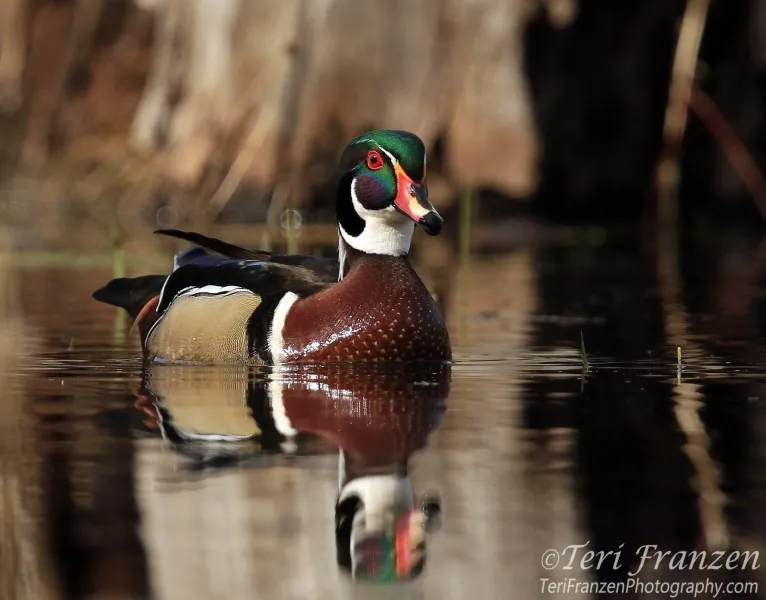 A male Wood Duck, known as a drake, showcasing his vibrant nuptial plumage while gracefully floating on the water.
A male Wood Duck, known as a drake, showcasing his vibrant nuptial plumage while gracefully floating on the water.
Courtship and Breeding Rituals
The autumn months signal the start of a crucial period for wood ducks as they prepare for the upcoming breeding season. While migrating south to warmer climates, drakes and hens begin to form pairs. This pairing often occurs during their winter migration or in their wintering grounds, with drakes following hens back to their native nesting sites once spring arrives. This strong pair bond is essential for successful reproduction. Wood ducks demonstrate specific courtship behaviors, with one of the most notable being mutual grooming. The drake will often preen his mate as a profound display of affection, reinforcing their bond.
Upon returning to their summer homes in early spring, such as the thawing ponds and lakes of New York, the mated pairs begin their breeding activities. While the pair bond is generally strong, it’s not uncommon to observe an “interloper” drake nearby, subtly waiting to step in should the primary pair bond falter. This complex social dynamic highlights the competitive nature of reproduction within the species. Observing these delicate interactions, like a drake meticulously grooming his hen, offers a rare glimpse into the intimate world of wood duck relationships. These behaviors are not only vital for pair formation but also contribute to the overall reproductive success of the species.
 A male Wood Duck lovingly grooms his female mate, a tender display of affection that strengthens their pair bond during the crucial breeding season.
A male Wood Duck lovingly grooms his female mate, a tender display of affection that strengthens their pair bond during the crucial breeding season.
Nesting and Parental Responsibilities
Once the hens begin nesting and incubating their eggs, a distinct shift occurs in the social behavior of the drakes. During this period, the male wood ducks gather in small, loosely knit social groups, often referred to as “boy’s clubs.” These gatherings are typically observed on logs or sheltered areas of the pond, where the drakes rest, preen, and engage in minimal social interaction. Such groupings allow the drakes to conserve energy and remain vigilant while their mates are occupied with incubation.
As the nesting cycle progresses and the hens are deeply involved in brooding, the pair bond between the drake and hen typically severs. This behavioral separation is common among many duck species, where the male’s presence is no longer required for raising the young ducklings. Ducklings are relatively independent soon after hatching, primarily needing the hen’s protection and brooding. The absence of the male helps reduce potential attention from predators, safeguarding the vulnerable young. During this time, the drakes also undergo molting into their summer eclipse plumage, a period where they lose their vibrant feathers and become more retiring, further reducing their visibility to predators as they become temporarily flightless.
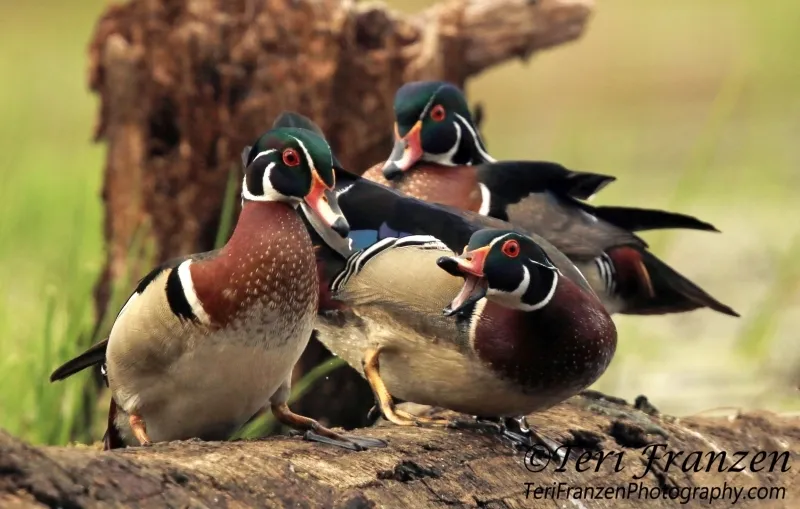 Three male Wood Ducks gather on a log, forming a "boy's club" while the hens are busy nesting and incubating eggs.
Three male Wood Ducks gather on a log, forming a "boy's club" while the hens are busy nesting and incubating eggs.
Duckling Development and Early Life
The arrival of the first brood of wood ducklings marks a vibrant new phase in the wetland ecosystem. A hen wood duck diligently guides her offspring, teaching them essential survival skills. Ducklings are precocial, meaning they are active and can feed themselves shortly after hatching, but they rely heavily on their mother for warmth, protection, and guidance. It’s a common and endearing sight to see a hen swimming with her brood closely following, sometimes even riding on her tail feathers for a quick rest or added security.
As the ducklings grow, their exploratory behaviors become more evident. Young wood ducklings are naturally attracted to movement and brightly colored objects, often testing these curiosities to determine if they are edible. This innate inquisitiveness is a crucial part of their learning process, helping them identify potential food sources in their environment. From approximately five to seven weeks old, the ducklings gradually begin to assert their independence, straying further from their mother and interacting more with their siblings or other young ducks. During this developmental stage, physical differences between male and female ducklings start to become apparent, with young drakes developing a prominent white saddle marking on their faces.
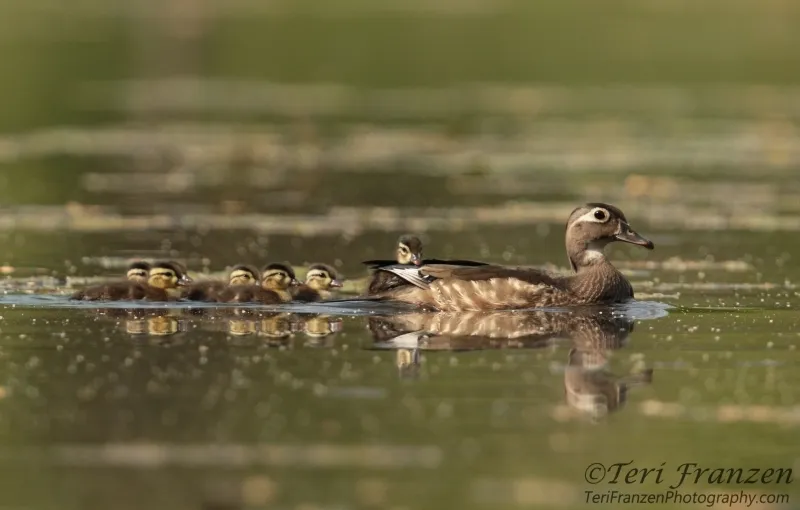 A female Wood Duck leads her brood of ducklings across the pond, with one adventurous duckling riding on her tail feathers.
A female Wood Duck leads her brood of ducklings across the pond, with one adventurous duckling riding on her tail feathers.
Unique Social and Survival Strategies
Wood ducks sometimes exhibit a fascinating behavior known as inter-species nest parasitism. This occurs when a hen of one species lays her eggs in the nest of another species, relying on the foster parent to incubate and raise her young. A notable example involves wood ducks and hooded mergansers, which often share nesting habitats. A wood duck hen might lay an egg in a hooded merganser’s nest, or vice versa, leading to mixed broods where the foster duckling is raised as one of the family. Research indicates that the survival rates of these foster ducklings are comparable to those of their biological siblings, showcasing the adaptability of these maternal behaviors.
Another interesting aspect of wood duck behavior, though less common, is diving. As dabbling ducks, wood ducks typically forage at or just below the water’s surface, preferring vegetation. They rarely dive for food unless something exceptionally enticing lies deeper. However, instances have been observed where entire wood duck families, particularly those with a foster hooded merganser duckling, exhibit frequent diving behavior. This suggests that the diving habits of a foster sibling, known for its strong diving capabilities, might influence the wood duck family’s foraging techniques, demonstrating a form of learned behavior within a mixed brood. These survival and social strategies underscore the complex adaptations that allow wood ducks to thrive in their diverse environments.
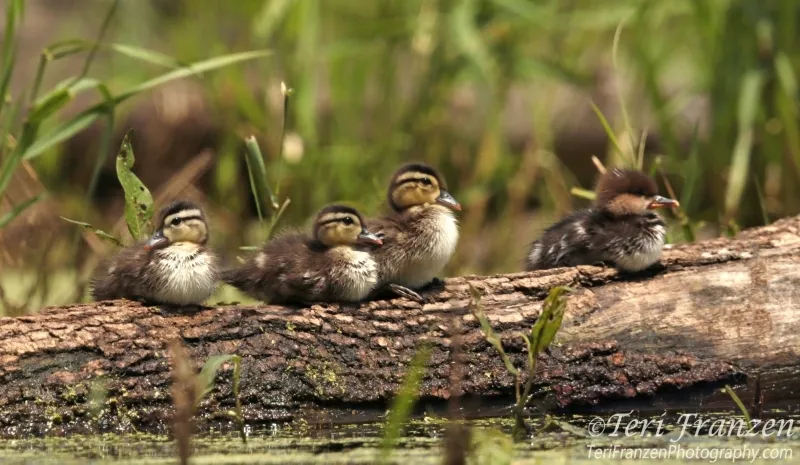 A Hooded Merganser duckling swims amongst Wood Duck ducklings, illustrating inter-species nest parasitism where a foster mother raises the young of another species.
A Hooded Merganser duckling swims amongst Wood Duck ducklings, illustrating inter-species nest parasitism where a foster mother raises the young of another species.
Dietary Habits and Foraging
The diet of a wood duck is primarily opportunistic, reflecting their “dabbling” nature. They are omnivores, typically foraging at the water’s surface or just below it for a mix of plant matter, insects, and small invertebrates. Their specific diet is heavily influenced by the availability of food in their habitat. Common food sources include seeds, acorns, berries, and various aquatic plants. They are also known to consume a range of insects such as dragonflies, beetles, and larvae, as well as spiders and small crustaceans.
While their diet predominantly consists of smaller items, wood ducks are not averse to more substantial prey when the opportunity arises. Instances have been documented where young drakes have successfully captured and consumed frogs whole, demonstrating a broader dietary flexibility than commonly assumed. This behavior involves skillful maneuvering of the prey before swallowing it headfirst. Such observations highlight the adaptive foraging strategies of wood ducks, allowing them to capitalize on available resources and diversify their diet beyond typical vegetarian and insect fare, especially during crucial growth periods or when other food sources are scarce.
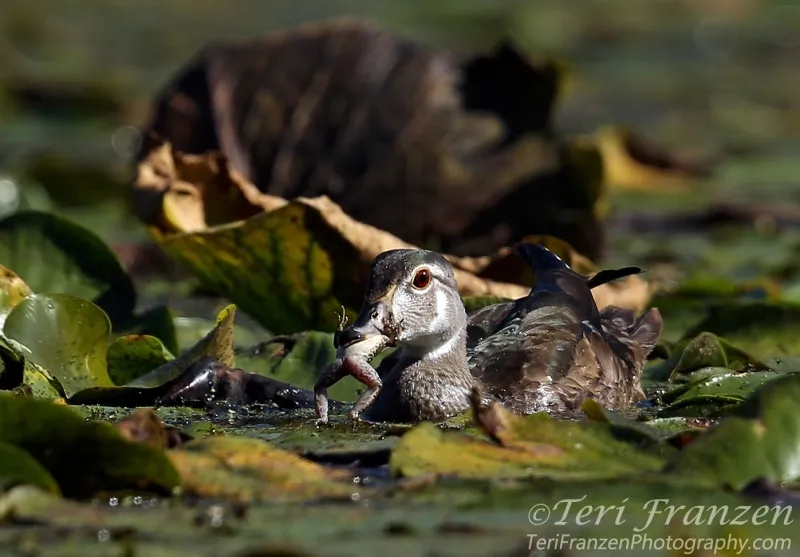 A young male Wood Duck skillfully maneuvers a captured frog, flipping it to swallow it whole.
A young male Wood Duck skillfully maneuvers a captured frog, flipping it to swallow it whole.
Seasonal Plumage and Migration
Wood ducks exhibit distinct changes in their plumage throughout the year, primarily influenced by breeding cycles and seasonal needs. The most striking is the nuptial plumage of the drake, which is a kaleidoscope of iridescent colors, essential for attracting mates during the breeding season. However, this magnificent display is not permanent. During the summer months, adult male wood ducks undergo a “molt” into what is known as eclipse plumage. In this phase, the drake loses his vibrant breeding colors and resembles the more subdued appearance of a hen or a sub-adult male. This drabber plumage provides better camouflage during a vulnerable period when they shed their flight feathers and cannot fly, making them “sitting ducks” for predators.
As autumn approaches, wood ducks begin their migration south, leaving their summer breeding grounds for warmer wintering habitats. This migratory journey is physically demanding, and the ducks become particularly skittish and cautious. Transient ducks passing through temporary stops are extremely sensitive to any disturbance, highlighting the importance of minimizing stress during their arduous travels. The sight of a small flock of wood ducks flying overhead in autumn signifies the close of another cycle, as they embark on their journey to winter homes before returning in the spring to repeat their fascinating behavioral patterns.
Conclusion
The wood duck’s annual cycle is a rich tapestry of behaviors, from the intricate displays of courtship and the dedicated care of hens for their broods to the unique social dynamics of drakes and the fascinating adaptations like inter-species nest parasitism. Observing these creatures offers a profound look into the natural world’s intricacies, revealing their resilience, adaptability, and the subtle ways they interact with their environment. Their seasonal plumage changes and migratory instincts further underscore their connection to the rhythms of nature. Understanding wood duck behavior not only enriches our appreciation for these remarkable birds but also emphasizes the importance of preserving their wetland habitats for future generations. Continue exploring the natural world around you to discover more about these incredible “ornaments to a river.”
Reference: The observations and details in this article are based on the extensive personal experiences and photographic documentation by Teri Franzen, originally published on terifranzenphotography.com and featured in “Wildlife Photographic Magazine” in 2016.
